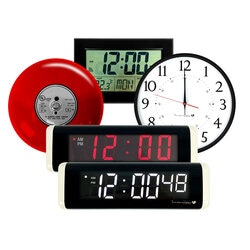+1 888 123 4567
Synchronized Clocks Improve Performance
Innovation Wireless

Having actually synchronized clocks as a firm criterion is an important structure whereupon several advantages are understood, not the least of which is much better efficiency. The concept behind synchronized clocks is for all organizational wrist watches to be readied to the specific very same time. This must hold despite the number of clocks there are throughout the organization and regardless of exactly how widespread is the school or degree of structures.
Clocks can be synchronized with cords or wirelessly. Nowadays the majority of consumers opt for a cordless setup due to the fact that it saves money on installation and upkeep costs, and as a whole provides a whole lot more adaptability. But for pre-existing (older) systems that have all the circuitry currently in place, it commonly makes even more feeling to boot up integrating with those cables.
Synchronization can be attained manually if you have at a lot of 2 or 3 clocks, but when attempting to obtain hundreds in sync, a computerized system is required. Additionally, trying to integrate individually and sequentially is very error-prone. So, what we require is to relay a signal to all clocks at once-- kind of like firing a starting gun for a race-- and to prepare each clock to get the signal and reset itself to the provided time.
To complete this preparation, the watches need to be outfitted with an electronic receiver that will certainly acknowledge not just the triggering signal but also the moment ingrained with it. The response activity is just to establish its present time to that in the package. Once more, this system functions whether the packet is sent over network wire links or wirelessly.
Because both of these media are electro-magnetic, the signals travel at light rate. Thus, the trigger reacts in plain split seconds. It matters not just how far from or how near to the various clocks are with respect to the signal source; a microsecond is six orders of size quicker than a 2nd.
As soon as the logistics of synchronization are exercised, one uncovers that it can boost efficiency in a number of various means. It currently permits administrators to improve procedures by eliminating built-in slack to account for subtle timing offsets. Communication with consumers and workers additionally ends up being extra efficient and effective.
To put it simply, administrators are interested in enhancing the circulation of both procedures and info. They look for traffic jams and ineffectiveness and then see what methods could be applied to those situations in an effort to deal with or improve them. A more detailed analysis of a pair instances might show instructive.
First, take into consideration the issue of maximizing class routines in numerous academic environments. Time has to be set aside between durations for accommodating trainee traveling across school. Reducing this duration (to make best use of direction time) comes to be an increasing number of tough as schools obtain larger and bigger.
Synchronized clocks (and bells) are vital right here since any type of lag in the period end-mark among various classrooms counts against the objective. An evenly disseminated message of duration end and duration start accomplishes the greatest efficiency.
The PA system is likewise made use of in institutions to communicate public messages to pupils and team. Right here, the synchronizing is amongst class speakers, managed by the clocks. Targeting the message to a subset of all class (to avoid interfering with guideline) can be completed with centralized or localized handbook overrides.
Second of all, makers take discomforts to make the most of production line productivity. Once again, synchronization is key to make employee handoff the most streamlined possible without either event having to wait.
An additional useful device is to distribute message boards throughout the plant. Messages can be all at once upgraded centrally, and workers can read them whenever it's convenient
Various work environments ask for different ways to optimize operations, however they all rely on the same principles: synchronized clocks improve productivity.
school synchronized wall clocks